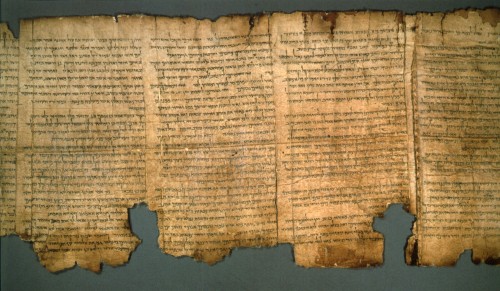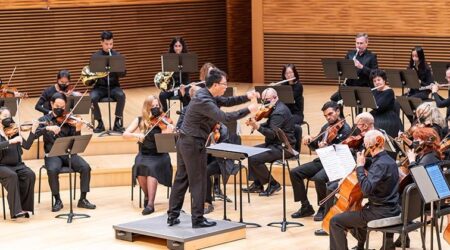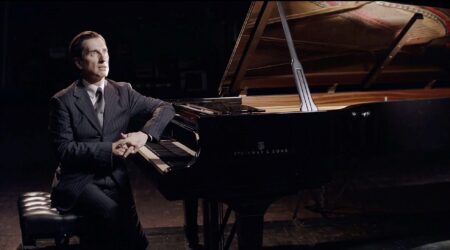A Look at the Dead Sea Scrolls: In Person and Online
While I reside and work in the heart of California’s Silicon Valley, where to be a Googler is everyone’s dream, my zest for history exploded as I examined the digitized, gloriously high definition images of the Dead Sea Scrolls, thanks to the collaborative partnership of the Israel Museum and the creative technology geniuses of Google. […]
While I reside and work in the heart of California’s Silicon Valley, where to be a Googler is everyone’s dream, my zest for history exploded as I examined the digitized, gloriously high definition images of the Dead Sea Scrolls, thanks to the collaborative partnership of the Israel Museum and the creative technology geniuses of Google. It also prompted me to enthusiastically accept an invitation by the Israeli Ministry of Tourism for the newly offered Adventure Trip to Israel, which, among other fascinating attractions on their amazing Survival of the Fittest itinerary, included a visit that was very important to me: to the Israel Museum’s iconic Shrine of the Book in Jerusalem, the home to the renowned Dead Sea Scrolls where I could view the original and rare ancient manuscripts of the Hebrew Bible.
The Dead Sea Scrolls are a collection of 972 texts from the Hebrew Bible and extra-biblical documents which were discovered between 1947 and 1956 in eleven caves near the community of Khirbet Qumran on the northwest shore of the Dead Sea, from which they derive their name. They are approximately 2000 years old, dating from the third century BCE to the first century CE and survived perfectly due to the particular climate inside the caves. Most of the scrolls were written in Hebrew, with a smaller number in Aramaic and Greek. In general, they were written on parchment, with the exception of a few written on papyrus. The vast majority of the scrolls survived as fragments – only a handful intact. Nevertheless, scholars have managed to reconstruct from these fragments approximately 850 different manuscripts of various lengths.
The dramatic story of the discovery of the first Dead Sea Scrolls has been re-told in numerous variations. And as the story goes, the first seven scrolls were found by chance by Muhammed edh-Dhib, a young Bedouin goat-herder of the Ta’amra tribe in January of 1947, when his search for a lost goat led him and two companions to a small opening in a cave (later given the name “Cave 1”) near Qumran. He threw a rock into the opening and when the surprising sounds of broken pottery ignited his curiosity, he made his way to the cave where he found its floor covered by debris, including the broken pottery. Along the wall stood a number of narrow clay jars, some with their bowl-shaped covers still in place, containing the Dead Sea Scrolls. The young man brought the scrolls for appraisal to a Bethlehem merchant who in turn showed the scrolls to Khalil Eskander Shahin, “Kando,” a local antique dealer and a cobbler, who sold four of the initial seven scrolls for 7 English pounds ($29 in 2003 U.S. dollars).

Arrangements with the Bedouin left the scrolls in the hands of a third party until a profitable sale of them could be negotiated. That third party, George Isha’ya, was a member of the east Jerusalem Syrian Orthodox Church, who soon contacted St. Mark’s Monastery in the hope of getting an appraisal on the nature of the texts. News of the find then reached Metropolitan Athanasius Yeshue Samuel, better known as Mar Samuel. After examining the scrolls and suspecting their antiquity, Mar Samuel expressed an interest in purchasing them, which he did: the now famous Great Isaiah Scroll, Community Rule Scroll, Commentary on the Habakkuk Scroll, and the Genesis Apocryphon.
As more scrolls soon surfaced in the antiquities market, three of the scrolls, The War Scroll, Thanksgiving Hymns, and the more fragmented Isaiah scroll, were immediately purchased by archeologists Professors Eliezer Sukenik and Benjamin Mazar on behalf of the Hebrew University in Jerusalem.
In 1948, Samuel smuggled the four scrolls in his possession to the United States. It was only in 1954 that the archeologist Yigal Yadin, son of professor E. Sukenik, managed to return the remaining scrolls to Israel after purchasing them for $250,000 after noticing the “For Sale” ad in the Wall Street Journal.
Over the next few years, from 1949 to 1956, additional fragments of some 950 different scrolls were discovered, both by Bedouins and by a joint archaeological expedition of the École Biblique et Archéologique Française and the Rockefeller Museum, under the direction of Professor Father Roland de Vaux. Since then, no further scrolls have come to light, though excavations have been carried out from time to time at the site and nearby.
The discovery of the Dead Sea Scrolls represents a turning point in the study of the history of the Jewish people in ancient times. The 2000 year-old scrolls contain the earliest known copies of every book of the Hebrew Bible, (except the Book of Esther) along with hymns, calendars, and psalms, as well as apocryphal texts and descriptions for rituals of a Jewish sect at the time of Jesus. The texts, most of them written on parchment, some on papyrus, date from the third century B.C. to the first century A.D. and shed light on the history of Judaism and early Christian life.
The Dead Sea Scrolls offer critical insight into Jewish society in the land of Israel during the Second Temple Period, the time of the birth of Christianity and Rabbinic Judaism. Five complete scrolls from the Israel Museum have been digitized for the project and are now available online: the Great Isaiah Scroll; the Temple Scroll; the War Scroll; the Community Rule Scroll; and the Commentary on the Habakkuk Scroll.
The Great Isaiah Scroll: Inscribed with the Book of Isaiah and dating from circa 125 BCE, it is the only complete ancient copy of the biblical book in existence.
The Temple Scroll: From the early first century CE, it claims to provide the details of God’s instructions for the construction and operation of the Temple in Jerusalem. Written on animal skin only one-tenth of a millimeter thick, the Temple Scroll is the thinnest parchment scroll ever found among the Dead Sea Scrolls.
The War Scroll: Dates to the late first century BCE or early first century CE and describes a confrontation between the “Sons of Light” and the “Sons of Darkness,” which would last forty nine years, ending with the victory of the “Sons of Light” and the restoration of Temple practice according to their beliefs.
The Community Rule Scroll: Sheds light on the Community’s way of life, dealing with subjects such as the admission of new members, conduct at communal meals, prayer, cleansing rituals, and theological doctrines.
The Commentary on the Habakkuk Scroll: Interprets the first two chapters of the biblical book of the prophet Habakkuk in a unique style which makes it a key source of knowledge of the spiritual life of the secluded Qumran community, shedding light on the community’s perception of itself.
“The Shrine of the Book where the Dead Sea Scrolls are kept is the holiest of the holy places on earth,” says Dr. Adolfo Roitman, curator of the Dead Seas Scrolls museum. “The Great Isaiah Scrolls are our ‘Mona Lisa’, the most important culture treasure of the Jewish nation.” The second largest scroll discovered in the Qumran caves, it contains all the 66 chapters of the prophet Isaiah listed in the Bible. In its manuscripts it mentions Jerusalem, the same city where the Shrine of the Book is located and where the original Dead Sea Scrolls collection is displayed.
The Study Center’s 80-seat theater is used for lectures and conferences, and features a short narrative film for general visitors, exploring aspects of Jewish identity during the Second Temple period, through a fictional narrative as seen through the eyes of a young Jerusalem priest and a teenager from Qumran, the ancient site where the Dead Sea Scrolls, now housed in the Shrine, were originally discovered.
Who wrote the Dead Sea Scrolls? Scholars are divided about who authored the Dead Sea Scrolls and how the text got to Qumran. Some argue that the scrolls were written at the site itself while others say they were written in Jerusalem or elsewhere in Israel. Qumran itself was excavated by Roland de Vaux in the 1950s. He came to the conclusion that the site was inhabited by a religious sect called the Essenes who wrote the scrolls and stored them in caves. Among the finds he made were water pools, which he believed were used for ritual bathing, and multiple inkwells found in a room that became known as the “scriptorium.” Based on his excavations, scholars have estimated the population of the site was as high as 200.
But most recent archeological work, conducted by the Israel Antiquities Authority, suggest that the site could not have supported more than a dozen people and had nothing to do with the scrolls themselves. They believe that the scrolls were deposited in the caves by refugees fleeing the Roman army after Jerusalem was conquered in 70 A. D. The scholars also believe that the site came into existence around 100 B.C. as a military outpost used by the Hasmoneans, a Jewish kingdom that flourished in the area. After the Romans took over Judea in 63 B.C., the site was abandoned and was eventually taken over by civilians who used it for a pottery production. They found that the pools de Vaux discovered include a fine layer of potters’ clay.
Obviously, with the availability of a digitized copy of the scrolls, more work will be researched by scholars throughout the world and new historical facts and confirmations will be discovered. Thanks to these remarkable finds, the knowledge of Jewish society in the land of Israel during the Hellenistic and Roman periods as well as the origins of rabbinical Judaism and early Christianity has been greatly enriched.
“Google’s passion is to organize the world’s information and make it accessible and useful,” said Professor Y. Matias, managing Director of Google’s R&D center in Israel, who was previously involved in similar projects, including the Google Art project, the Yad Vashem Holocaust Collection, and the Prado Museum in Madrid.

“The Google tool website allows browsers to zoom into the text. The Great Isaiah Scroll can be searched by column, chapter, and verse, including the famous ‘and the wolf shall dwell with the lamb.’ It is accompanied by an English translation tool and includes an option for users to submit translations of verses in their own languages.”
I was absolutely mesmerized as our Adventure Trip group of five journalists from the US and Canada entered the dimly lit Shrine of the Book museum in anticipation of viewing and touching (oops, here come the museum’s watchful guards), and finally seeing this remarkable collection of the authentic Dead Sea Scrolls. The history came alive as we followed and attentively listened to Ofir Jacobson, our exceptionally talented and multitasking Israeli Adventure Trip guide, who speaks several languages fluently and holds a Master’s degree in comparative religions.
The realization that I just explored the most astonishing archeological find in its original presentation was so captivating and so overwhelmingly exciting that I simply had to take a short break and venture for a walk in the serene setting of the museum’s Art Garden. Designed by the renowned landscape architect and sculptor Isamu Noguchi as a unique blend of Zen principles, Mediterranean setting, and Western art, it is considered one of the world’s great sculpture gardens. Surrounded by the stunning works of Jacques Lipchitz, Henry Moore, and Pablo Picasso spread out around the garden, I found a bit of contemporary respite from the ancient manuscripts. A deep breath of fresh air and a cup of refreshing cold water was all I needed to relax and continue my educational journey back to the museum.
When asked, “What archeological discovery has had the all-time greatest Biblical impact,” Eliyahu Honig, Former Associate Vice President, now Member of the Board of Governors at the Hebrew University explained, “The scrolls throw important light on the Old Testament texts. Both the fragments of nearly every book of the bible and the full text of the Isaiah Scroll are almost identical with the Masoretic texts which we use today and which were transmitted from generation to generation by mouth or in script for nearly 2000 years – in itself amazing or miraculous.”
At the press conference for the launch of the website, the inevitable question arose: Wouldn’t the accessibility of such content on the internet alleviate the need to actually see the exhibits in museums? “Absolutely not,” said James Snyder, Director of the Israel Museum in Jerusalem. “Putting stuff like this on the internet engages people and actually brings them to the museum, many of them inspired by visits to the museum’s website.” I agree, I was certainly inspired! And thanks to the very convenient non-stop El Al Airlines flight from Los Angeles to Tel Aviv, I was on my way to converge on the holy sites and explore the constellation of the past, present, and future of astonishing archeological and adventure sites of Israel.
The Israel Museum, the largest cultural institution in Israel, houses encyclopedic collections of works dating from prehistory to present day archeology, the fine arts, and Jewish art and life. Since opening in 1965, the Museum has built a collection of nearly 500,000 objects representing the full scope of artistic creativity and world material culture.
For information on:
The Israel Museum and the Shrine of the Book please visit: www.imj.org.il
The Adventure Trip to Israel please visit: www.goisrael.com
Professional guide Ofir Jacobson can be reached at: ofirjac@gmail.com
Lina Broydo immigrated from Russia, then the Soviet Union, to Israel where she was educated and got married. After working at the University in Birmingham, England she and her husband immigrated to the United States. She lives in Los Altos Hills, CA and writes about travel, art, style, entertainment, and sports. She hardly cooks or bakes, not the best of ‘‘balabostas’’ her beloved beautiful Mom, Dina, was hoping for. Therefore, she makes reservations and enjoys dining out.





